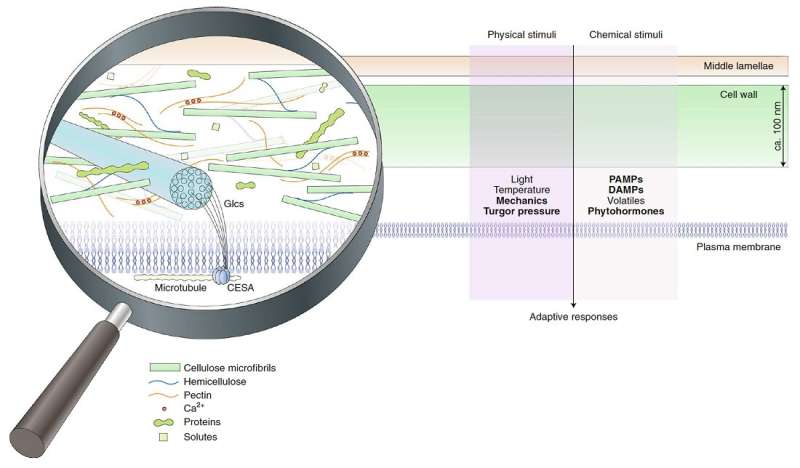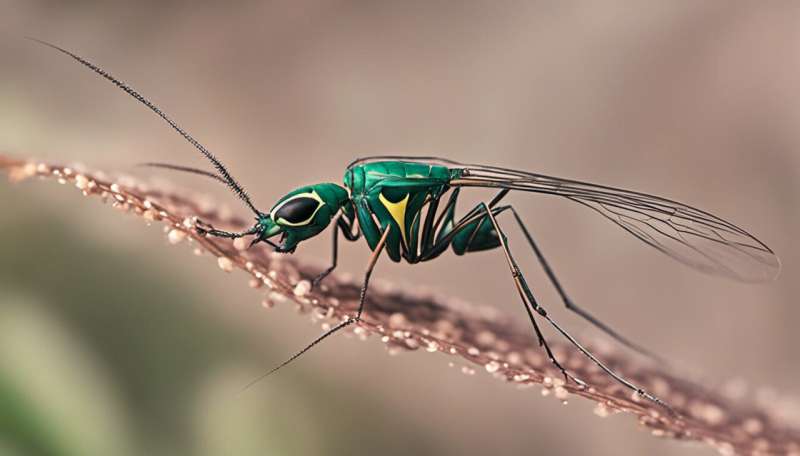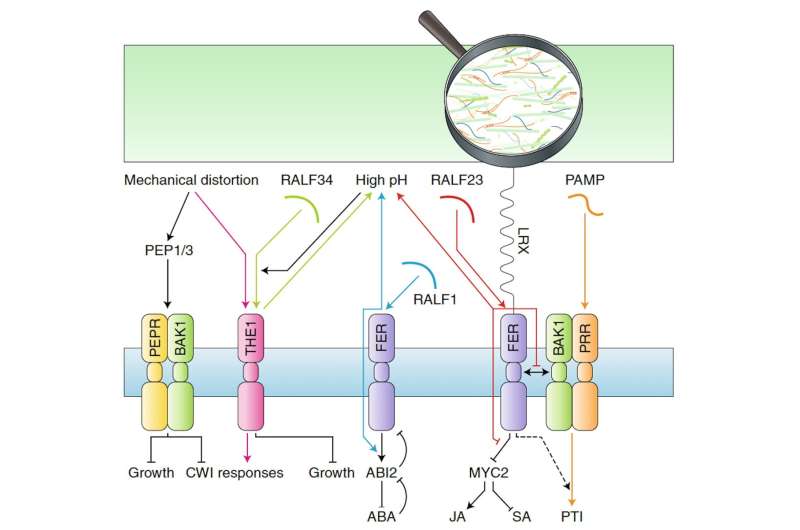Insect or virus? How plants know

Most plants have plenty of enemies, from insects and other grazing creatures to various diseases, droughts and many other stressors.
As with humans, plants respond to injuries or illnesses by initiating various defense measures. But a viral infection requires a completely different response than desiccation, of course.
To know more about its attacker, the cell relies on mechanical and chemical signals, much in the same way that we use our senses to figure out what we might be willing to eat in an exotic restaurant. Smell and taste are chemical cues, the structure of food is a mechanical cue.
Humans respond appropriately to what their senses tell them because they have dedicated structures that allow both simple responses (reflexes) and more complex ones (fight or flight), both of which are controlled by a unifying and coordinating centers (the brain).
So how do brainless plants defend themselves appropriately?
Research valuable for food crops
The answers to this question may be especially important as scientists develop new varieties of food crops like rice and maize. The research has great potential value, both financially and in meeting the food needs of an ever-growing human population. Corn accounts for around 40 percent of the world's grain supply. Rice is the main food source for about half of the world's population.
A review article recently published in Nature Plants provides some of the answers to this question.

Thorsten Hamann is a professor at NTNU's Department of Biology and was the senior author of the publication. He and several colleagues are working with a plant called thale cress (Arabidopsis thaliana). This small flowering plant is widely used in research as what is called a model organism.
A model organism like thale cress is used in plant research because many of its properties are considered to be more or less representative of food and bioenergy crop plants, such as rice, brassica, poplar and maize. But thale cress is much faster and easier for researchers to work with.
Cell walls aren't just dead material
Decades ago, biologists regarded the plant's outer cell walls as little more than dead material that held up the rest of the plant's more important and exciting parts. But that belief no longer holds.
"Cell walls are dynamic structures that provide mechanical support during growth and development and that help the plant adapt to environmental change," says Hamann.
A plant's cell walls are much stronger than the thin structures surrounding human cells, which can also give rise to our skin. This is necessary because the pressure inside plant cells is roughly equivalent to the pressure in our car tires. The cell walls are largely made up of cellulose microfibers, a strong material that can handle this pressure.
"The plant walls make sure that the cells don't explode," Hamann notes.
But the abilities of the cell walls go significantly above and beyond preventing explosions.

The plasma membrane
If the cell walls are to respond to environmental changes in an adaptive manner, there must be a mechanism in place that allows them to do this. This mechanism must monitor the state of the cell wall and initiate changes in cell metabolism to allow it to adapt.
This mechanism has actually been previously described in yeast cells, the single-celled organisms that can be used to make beer, bread or wine. This suggests that the plant mechanism is derived from an ancient process that regulated interactions between single-celled organisms and their environment already a long time ago.
Professor Hamann's lab has been investigating how plant mechanisms act and has shown how these mechanisms help with plant defense and development.
Currently, postdoctoral fellow Lauri Vaahtera and Ph.D. candidate Julia Schulz are working on understanding the principles that regulate the mechanism and alter the plants' chemical composition.
"The outer part of the cell wall is rigid, but between the cell wall and the rest of the cell is a plasma membrane that is responsive to changes in the cell walls. A lot of the defense activity is coordinated in this transition area, called the apoplast, between the outer cell wall and the rest of the cell," Hamann says.
Short protein molecules called peptides are central to the process, because they can function as signaling agents. These signaling agents bind to different receptors to trigger specific defense responses depending on the type of stress.

Regulating responses through changes in acidity
"One way that plants induce specific defense measures is by changing acidity (pH) in the apoplast when exposed to stress," says Hamann.
Take for example a plant that is exposed to a mechanical stressor, like a locust chewing on a leaf.
The chewing locust damages the cell wall and causes a loss of pressure in the containment. This triggers a reaction requiring the plasma membrane localized receptor THESEUS1, or THE1 for short. The reaction in turn activates defense measures designed to prevent further pressure loss by initiating repairs.
The defense measures also involve other receptors and are regulated by RALF peptides. One of them (RALF34) binds to THE1, in a pH dependent manner. For example, at pH 7.8, the peptide binds very strong to the plasma membrane localized receptor, while at the more acidic pH of 6.5, binding is not detectable.
The researchers say it is important to note that the pH is not regulated by mechanical stressors alone but also by other signaling agents, such as something called PAMPs, which are derived from pathogenic bacteria and fungi. Thus, changes in the pH can be caused by several inputs and can thus integrate these different inputs to activate responses suitable for either chewing locusts or bacteria.
This means that the pH functions almost like an on/off switch, although the NTNU researchers think it may actually work like a dimmer switch, where the extent of the acidity, and thus the response, can be regulated in a graduated manner.
Complex, interwoven mechanisms
In other words, plant cells are able to integrate different inputs and activate differential responses using tightly interwoven and complex mechanisms, where mechanical signals caused by mechanical stressors like locusts and chemical signals like PAMPs and peptides are combined to fine-tune responses.
What's most notable is that there is no central entity, like a brain, that drives the response. Instead, every single plant cell is theoretically capable of responding to the different inputs. It's almost as if the whole plant consists of a multitude of single cell-sized computing units.
More information: Lauri Vaahtera et al. Cell wall integrity maintenance during plant development and interaction with the environment, Nature Plants (2019). DOI: 10.1038/s41477-019-0502-0
Journal information: Nature Plants
Provided by Norwegian University of Science and Technology




















